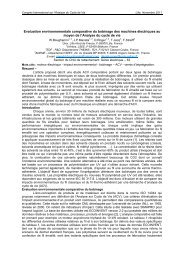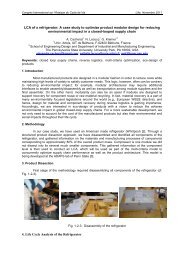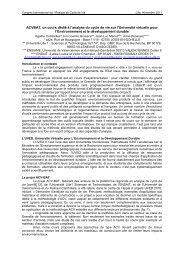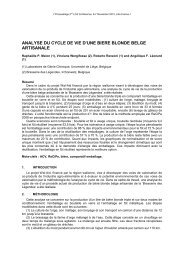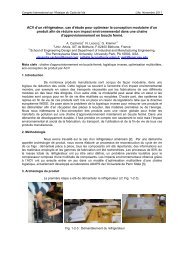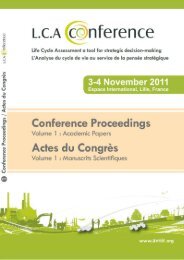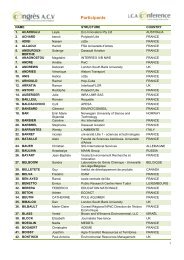Assessing Temporary Carbon Storage in Life Cycle Assessment and ...
Assessing Temporary Carbon Storage in Life Cycle Assessment and ...
Assessing Temporary Carbon Storage in Life Cycle Assessment and ...
Create successful ePaper yourself
Turn your PDF publications into a flip-book with our unique Google optimized e-Paper software.
5 Conclusions<br />
This report summarises the ma<strong>in</strong> methodological issues regard<strong>in</strong>g the benefits of temporary carbon<br />
storage <strong>and</strong> associated metrics that were identified <strong>in</strong> the presentations <strong>and</strong> subsequently discussed<br />
throughout the workshop.<br />
Climate benefits of an isolated temporary carbon storage event arise solely when time preferences are<br />
reflected <strong>in</strong> the method used. This means that account<strong>in</strong>g for any benefits relies on value-laden<br />
methodological decisions, such as the choice of a time horizon beyond which impacts are not<br />
considered. Indeed, the longer the time horizon adopted for <strong>in</strong>tegration of radiative forc<strong>in</strong>g or impacts,<br />
the lower the benefits are from temporary carbon storage. This will only be different if the temporary<br />
storage is repeated, essentially becom<strong>in</strong>g a permanent removal from the atmosphere.<br />
If temporary storage is considered then it is common practice to adopt a 100-year time horizon us<strong>in</strong>g<br />
the Global Warm<strong>in</strong>g Potential <strong>in</strong>dex. <strong>Temporary</strong> storage benefits are then generally based on the<br />
Moura-Costa <strong>and</strong> Lashof approaches; assum<strong>in</strong>g that (sequestration <strong>and</strong>) storage of 1 tonne for 48 <strong>and</strong><br />
100 years is essentially equivalent to not emitt<strong>in</strong>g 1 tonne.<br />
However, no clear consensus has been reached from these discussions regard<strong>in</strong>g whether or not to<br />
account for temporary carbon storage <strong>in</strong> general <strong>and</strong>, if so, which method to employ. The choice of a<br />
100-year time horizon equally rema<strong>in</strong>s controversial<br />
S<strong>in</strong>ce the benefits given to temporary carbon storage rely on value-laden choices, if considered then it<br />
is important to make them explicit <strong>and</strong> transparent when us<strong>in</strong>g any account<strong>in</strong>g method. Both short <strong>and</strong><br />
long term time horizons should be considered.<br />
It was suggested to do more research <strong>in</strong> order to improve climate-change modell<strong>in</strong>g <strong>in</strong> LCA to <strong>in</strong>clude<br />
two other <strong>in</strong>dicators (i.e. <strong>in</strong>stantaneous temperature <strong>in</strong>crease <strong>and</strong> rate of temperature <strong>in</strong>crease), s<strong>in</strong>ce<br />
they provide <strong>in</strong>formation on different types of climate-change impact, <strong>and</strong> can lead to different<br />
conclusions than the s<strong>in</strong>gle use of cumulative radiative forc<strong>in</strong>g. Furthermore, research is warranted on<br />
the dynamics of the carbon cycle (e.g. changes <strong>in</strong> s<strong>in</strong>ks – biospheric, atmospheric <strong>and</strong> oceanic – are<br />
<strong>in</strong>terdependent <strong>and</strong> cannot be assessed <strong>in</strong> the same l<strong>in</strong>ear way as fossil emissions with GWP). This is<br />
because any change <strong>in</strong> biospheric carbon stocks may be partially or totally compensated by the <strong>in</strong>verse<br />
process from other s<strong>in</strong>ks (e.g. oceans), so this dynamism needs to be addressed.<br />
21



